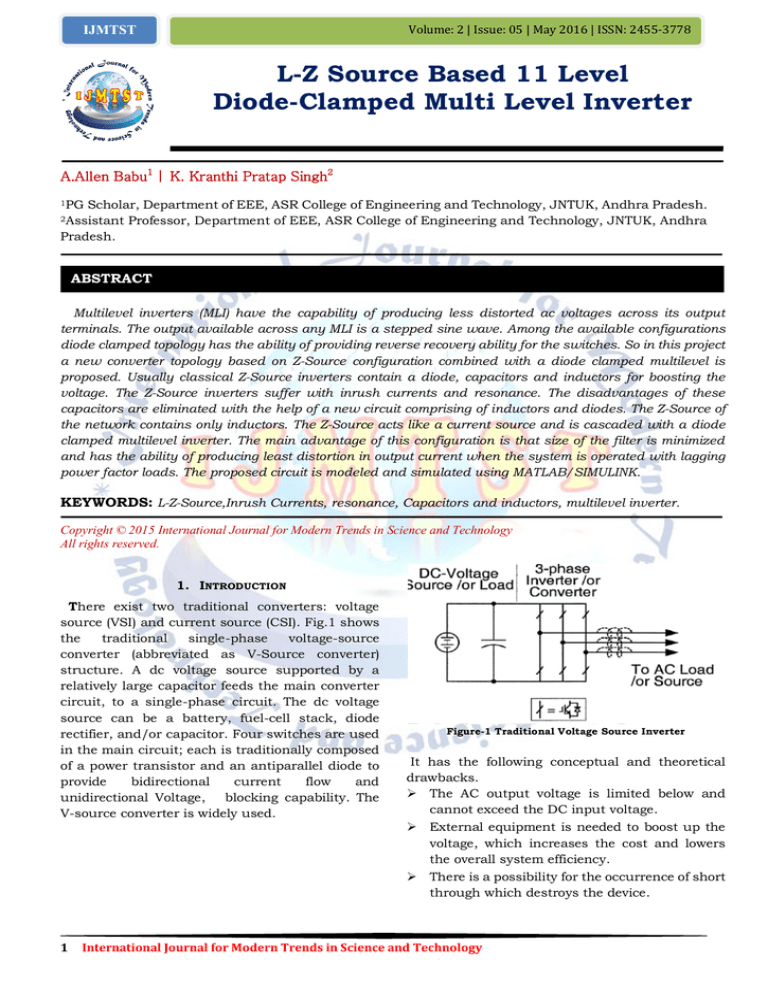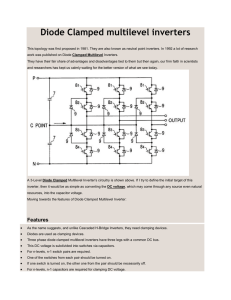
Volume: 2 | Issue: 05 | May 2016 | ISSN: 2455-3778
IJMTST
L-Z Source Based 11 Level
Diode-Clamped Multi Level Inverter
A.Allen Babu1 | K. Kranthi Pratap Singh2
1PG
Scholar, Department of EEE, ASR College of Engineering and Technology, JNTUK, Andhra Pradesh.
Professor, Department of EEE, ASR College of Engineering and Technology, JNTUK, Andhra
Pradesh.
2Assistant
ABSTRACT
Multilevel inverters (MLI) have the capability of producing less distorted ac voltages across its output
terminals. The output available across any MLI is a stepped sine wave. Among the available configurations
diode clamped topology has the ability of providing reverse recovery ability for the switches. So in this project
a new converter topology based on Z-Source configuration combined with a diode clamped multilevel is
proposed. Usually classical Z-Source inverters contain a diode, capacitors and inductors for boosting the
voltage. The Z-Source inverters suffer with inrush currents and resonance. The disadvantages of these
capacitors are eliminated with the help of a new circuit comprising of inductors and diodes. The Z-Source of
the network contains only inductors. The Z-Source acts like a current source and is cascaded with a diode
clamped multilevel inverter. The main advantage of this configuration is that size of the filter is minimized
and has the ability of producing least distortion in output current when the system is operated with lagging
power factor loads. The proposed circuit is modeled and simulated using MATLAB/SIMULINK.
KEYWORDS: L-Z-Source,Inrush Currents, resonance, Capacitors and inductors, multilevel inverter.
Copyright © 2015 International Journal for Modern Trends in Science and Technology
All rights reserved.
1. INTRODUCTION
There exist two traditional converters: voltage
source (VSI) and current source (CSI). Fig.1 shows
the
traditional
single-phase
voltage-source
converter (abbreviated as V-Source converter)
structure. A dc voltage source supported by a
relatively large capacitor feeds the main converter
circuit, to a single-phase circuit. The dc voltage
source can be a battery, fuel-cell stack, diode
rectifier, and/or capacitor. Four switches are used
in the main circuit; each is traditionally composed
of a power transistor and an antiparallel diode to
provide
bidirectional
current
flow
and
unidirectional Voltage, blocking capability. The
V-source converter is widely used.
1
Figure-1 Traditional Voltage Source Inverter
It has the following conceptual and theoretical
drawbacks.
The AC output voltage is limited below and
cannot exceed the DC input voltage.
External equipment is needed to boost up the
voltage, which increases the cost and lowers
the overall system efficiency.
There is a possibility for the occurrence of short
through which destroys the device.
International Journal for Modern Trends in Science and Technology
L-Z Source Based 11 Level Diode-Clamped Multi Level Inverter
The ZSIs accomplish a single-stage power
conversion with buck-boost capabilities. In ZSIs,
both of the power switches in a leg can be turned
on at the same time and thereby eliminate the dead
time. This significantly improves the reliability and
reduces the output waveform distortion. Fig 2
shows shows the classical ZSI in which the
two-port impedance network couples the main
inverter circuit to the dc source. In order to
overcome the shortcomings of the classical ZSI, the
quasi-ZSI (qZSI) shown in Fig. 2(b) and SL-ZSI
shown in Fig. 2(c) were developed.
the main circuit at startup. The proposed topology
also provides a common ground for the source and
inverter.
Fig 3-L-ZSI with two inductors
2.1 Operating States:
Operation of L-ZSI takes place in n two states
shoot through states
Non shoot through states
Fig 4 shows L-ZSI with n inductors
Fig 4 –L-ZSI with n inductors
Fig 2- Z source topologies(a)classical
ZSI(b)quasi-ZSI(c)SL-ZSI
The Z-Source inverters suffer with inrush
currents and resonance. The disadvantages of
these capacitors are eliminated with the help of a
new circuit comprising of inductors and diodes.
The Z-Source of the network contains only
inductors. The Z-Source acts like a current source
and is cascaded with a diode clamped multilevel
inverter.
2.1.1 Shoot –through state:
In the shoot-through state, inverter side is
shorted by both the upper and lower switching
devices of any phase leg. During the shoot through
state, D1,2,D2,2, . . . , Dn−1,2 and
Dn,2areoff,whileD1,1,D1,3,D2,1,D2,3,.Dn−1,Dn−1
,3,Dn,1 andDn,3 are on. L1, L2 , . . ., Ln−1 and Ln
are connected in parallel, inductors L1, L2, . . . ,
Ln−1 and Ln store energy. Equivalent circuit is
shown in figure 5(a).
2. L-Z SOURCE INVERTER
Different to the original ZSI, the proposed
inverter has nocapacitor, and is composed of two
inductors (L1, L2 , and L1 = L2 ), and three diodes
(D1,D2 , andD3 ), as shown in Fig. 3. The
combination of L2 – L3 – D1 – D2 – D3 acts as a
switched inductor cell. The proposed topology
provides inrush current suppression, unlike the
traditional topologies, because no current flows to
2
Fig-5(a)operation of L-ZSI with n inductors in shoot through
state
International Journal for Modern Trends in Science and Technology
Volume: 2 | Issue: 05 | May 2016 | ISSN: 2455-3778
IJMTST
2.1.2 Non-Shoot through state:
In the non-shoot-through state, D1,2 ,D2,2,
..Dn−1,2 , and Dn,2 are on, while D1,1,D1,3,D2,1
,D2,3, . .Dn−1,1,Dn−1,3,Dn,1 , and Dn,3 are off.
L1, L2 , . . ., Ln−1 , and Ln are connected in series.
L1, L2 , . . ., Ln−1 , and Ln transfer energy from the
dc voltage source to the main circuit. Equivalent
circuit is shown in fig -5(b)
Fig-6 Diode-Clamped inverter of five level
4. CIRCUIT CONFIGURATION
Fig.7 shows a proposed system consisting of a
L-Z source with n=4 and 11 level diode clamped
inverter and LC filter connected to load and filter
used here is LC filter
Fig-5(b)operation of L-ZSI with n inductors in non shoot
through state
3. DIODE CLAMPED INVERTER
There are several drawbacks of two level inverter
in which the switching devices have limited ratings
.So that these cannot used effectively in high power
and high voltage applications. And also at high
switching frequencies these two level inverter has
high switching losses that leads to decrease in the
efficiency. If we consider the Multilevel Inverters,
These are suitable for high voltage and high power
applications. Because the switching device voltage
stresses are controlled. And increasing the number
of voltage levels in the inverter without requiring
higher ratings on individual devices can increase
the power rating. As the number of voltage levels
increases the harmonic content of the output
voltage waveform decreases significantly.
3.1 Structure and basic operating principle
Consists of series connected capacitors that
divide DC bus voltage into a set of capacitor
voltages A DCMI with n number of levels typically
comprises (n-1) capacitors on the DC bus Voltage
across each capacitor is VDC/(n-1) and no of
switches per leg is 2(n-1) From the figure we can
see the main purpose of the capacitor is to split the
dc source into equal voltages and they act as
energy sources for the inverter .The number of
capacitors require for 11- level (m-level) inverter is
11-1=10 i.e. (m-1) . The number of switching
devices per leg is 2 (m-1) i.e. 20 for eleven levels.
3
Figure 7: Circuit configuration of L-Z source based 11
level diode-clamped inverter
5. HELPFUL HINTS
Model schematic of LZ Source based diode
clamped multilevel inverter is shown in figure 6.
The multilevel inverter is controlled with sinusoidal
pulse width modulation. The proposed circuit is
simulated for different kinds of load. The voltage
available at the output terminals of LZ Source is
given in fig. Voltage available across the load
terminals and current through the load are
presented in figure and total harmonic distortion in
the output voltage and current for a load resistance
of 100 Ohm and inductance of 1 mh are shown in
fig respectively.
Figure 8: Simulation model of L-Z source 11 level
diode-clamped inverter
International Journal for Modern Trends in Science and Technology
L-Z Source Based 11 Level Diode-Clamped Multi Level Inverter
Figure 9: Simulation model of 11 level diode-clamped
inverter
Figure 13 : THD of output load voltage using FFT Analysis
tool
Figure 10: Simulation model of L-Z source with n=4
Figure 14: THD of load current using FFT Analysis tool
6. CONCLUSION
Figure 11: Current through inductors of L-Z source inverter
Z Source inverters operate as current source
inverters. To enhance the current carrying ability
of inverters the z source is replaced with LZ source.
This LZ Source is coupled to a 11 level diode
clamped inverter. It has been observed that the
multilevel level inverters will give better quality
output in terms of total harmonic distortion, less
distorted The switches that are used in LZ Source
are subjected to less voltage stress and a uniform
dc voltage is available across the output terminals
of LZ source..By connecting a filter across the
output terminals the distortion in output voltage
and current further reduced and give more
sinusoidal voltages and currents.
REFERENCES
Figure 12: Voltage across load and Current through load for
Load with 0.9 pf lagging.
4
[1] R. W. Erickson and D. Maksimovic, Fundamentals of
Power Electronics.Norwell, MA, USA: Kluwer, 2011.
[2] D. C. Jones and R. W. Erickson, “A nonlinear state
machine for dead zone avoidance and mitigation in a
synchronous noninverting buck-boost converter,”
IEEE Trans. Power Electron. , vol. 28, no. 1, pp.
467–480, Jan.2013.
[3] C. Yao, X. Ruan, and X. Wang, “Isolated buck-boost
dc/dc converters suit-able for wide input-voltage
International Journal for Modern Trends in Science and Technology
IJMTST
Volume: 2 | Issue: 05 | May 2016 | ISSN: 2455-3778
range,” IEEE Trans. Power Electron. , vol. 26,no. 9,
pp. 2599–2613, Sep. 2011.
[4] X. Ren, X. Ruan, H. Qian, M. Li, and Q. Chen,
“Three-mode dual-frequency two-edge modulation
scheme for four-switch buck-boost con-verter,” IEEE
Trans. Power Electron. , vol. 24, no. 2, pp. 499–509,
Feb.2009.
[5] Y. J. Lee, A. Khaligh, A. Chakraborty, and A. Emadi,
“A compensation technique for smooth transitions in
a noninverting buck-boost converter,”IEEE Trans.
Power Electron. , vol. 24, no. 4, pp. 1002–1016, Apr.
2009.
5
International Journal for Modern Trends in Science and Technology






